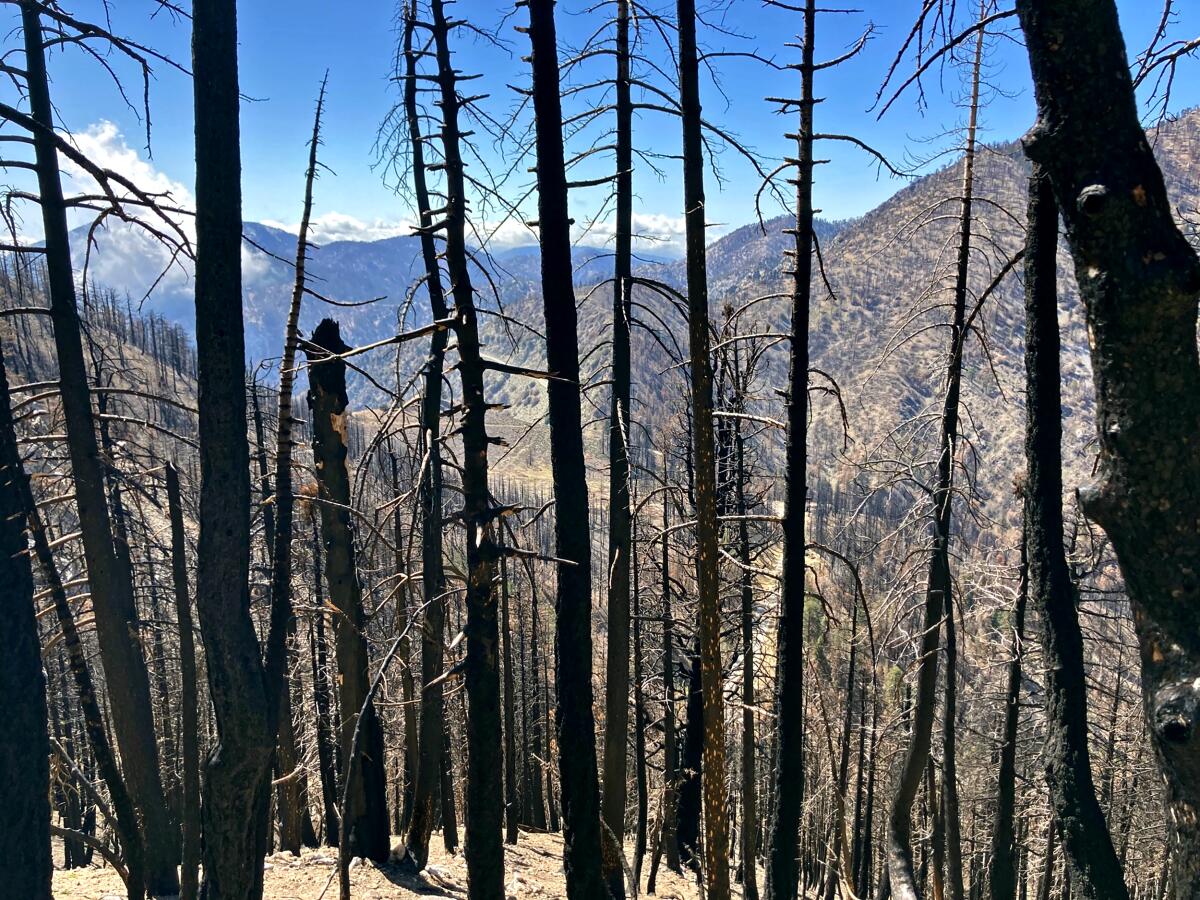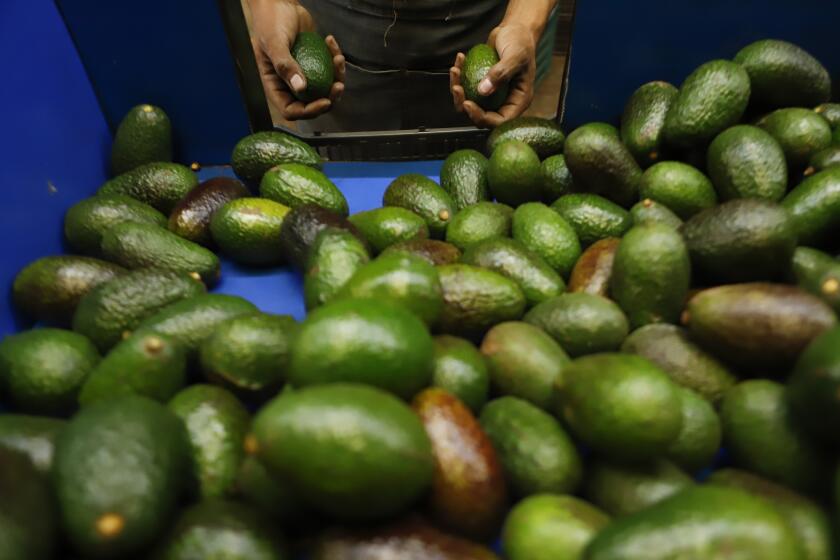Opinion: How climate change scars our forests and our souls

Good morning. Iâm Paul Thornton, and it is Saturday, July 30, 2022. Today, the high temperature will be dangerously warmer in Portland and Seattle than Los Angeles. With that in mind, letâs look back at the week in Opinion.
Fully aware of the power of jinxing, I made this observation recently to my wife: Summer so far has been pretty mild in Los Angeles, especially compared to the hellish misery inflicted on the rest of the country. The last time I tempted fate this way, it was August 2020, and I was trying to look on the bright side of our first pandemic-darkened summer. Close weather watchers might know how that turned out. Weâd go on to have a record-breaking Labor Day weekend heat wave, setting the stage for two catastrophic wildfires that fouled our air for weeks and left scars visible to this day on the mountains looming over Los Angeles.
And itâs those scars â both the obvious physical damage to our forests and the emotional pain from losing spaces sacred to us â that are the subject of our latest âHear Me Outâ video. I wish I could say this installment wasnât timely, but with the Mariposa Grove of giant sequoias in Yosemite National Park threatened twice this summer alone in separate burns, relevance isnât something we have to worry about when publishing anything on wildfires and imperiled forests.
About three months ago, reader John Kluge of North Hollywood sent The Times a letter to the editor that was at once sweet and heartbreaking. Responding to my April 30 commentary about hiking through a recently burned area of the San Gabriel Mountains, Kluge shared the story of âDavidâs tree,â a majestic pine in the Angeles National Forest where he scattered the ashes of his first domestic partner in 1995, a site chosen because âit seemed like Davidâs tree would live forever, or at least longer than me, a mere human.â But as Kluge tells it, the tree â once a broad, towering pine bearing evidence that it had survived previous fires â is now dead, a rotting heap of trunk and branches providing minimal evidence that it existed at all.
I was with Kluge when he set out with a few L.A. Times staffers to find the site of Davidâs tree. As he said in the video, we looked and looked and looked, but all we could do was bushwhack aimlessly through thick brush that had taken the place of the pines, which were almost certainly killed in the 2009 Station fire. Weâd come across a toppled trunk on its side and get our hopes up that this was Davidâs tree â âmy old friend,â as Kluge put it â and then deflate as we realized there was no way to distinguish one decomposing pine from another. It made those objective facts of global-spanning climate change feel intensely personal and hyper-localized for a moment.
To think a grove of pines once stood there, where thorny chaparral now makes human access almost impossible, is staggering. That this change took place over a fraction of a human lifetime doesnât leave much room to hope that other majestic conifers in the San Gabriel Mountains will survive, but as Kluge said at the end of his video, âTo just let it keep happening and not even trying ... that would be worse.â
Yosemiteâs sequoias survived the latest wildfire. Not all national parks will be so lucky. Mark Butler, the former superintendent of Joshua Tree National Park, warns that heroic feats to save national treasures like the Mariposa Grove cannot be sustained under climate change without more resources: âFighting out-of-control wildfires is far more expensive than preventing them, but for decades agencies such as the National Park Service and Forest Service have been consistently underfunded by Congress. This leaves them without enough staff or bandwidth to do work such as prescribed burns. The giant sequoias in the Mariposa Grove were successfully protected in great part due to this kind of preventive treatment. But only a fraction of the Sierra Nevada area has undergone regimens of this sort, and many other similar areas across the country are also under threat.â L.A. Times
Close the 6th Street bridge to cars. Just do it already. Walkers, runners, cyclists and revelers can enjoy L.A.âs new $600-million bridge without inflicting injury on others; you canât say the same for drivers, some of whom have been using the four-lane, wide-open span like the racing strip it was practically designed to be. Says The Times Editorial Board: âFocus on the crowds of pedestrians, cyclists, skateboarders, Instagrammers whoâve flocked to the bridge and made it their own. Despite less than ideal conditions (the speeding cars and the flimsy âprotectedâ bicycle lanes), the 6th Street Viaduct has become a spot for family strolls, bike rides, scenic views, even quinceaĂąera photos and a podcast recording. This is no mere roadway connecting Boyle Heights and downtown. Itâs an opportunity to rethink L.A. transportation infrastructure and public space. The viaduct was built for cars, but it should be reclaimed for people.â L.A. Times
Trump should be charged for crimes against the United States. The editorial board calls for the former president finally to face legal consequences for attempting a coup, and it isnât convinced by those who worry indicting Trump will only make matters worse: âThis seems like a legitimate risk, but not a sufficient reason to back away from the pile of evidence that points toward Trumpâs culpability. Justice is much larger than political considerations, and extending this argument more broadly would be akin to saying itâs too risky to try someone who tells a lot of lies and has a solid fan base. That shouldnât be how we determine which Americans are held to answer for potential crimes. Being famous or incendiary should not shield anyone from justice.â L.A. Times
Enjoying this newsletter? Consider subscribing to the Los Angeles Times
Your support helps us deliver the news that matters most. Become a subscriber.
Senate candidate Blake Masters doesnât just want to âbuild the wall.â Heâs building a dystopia. The Republican running to represent Arizona in the U.S. Senate talks like a Trump-loving, anti-immigrant populist, but columnist Jean Guerrero finds much more useful (and frightening) information about him from his close association with billionaire Peter Thiel: âItâs not hard to figure out what a Masters victory could mean. Thiel wrote in 2009: âI no longer believe that freedom and democracy are compatible.â He has also revealed the book that most shaped him: 1997âs âThe Sovereign Individualâ by James Dale Davidson and William Rees-Mogg. ... Tax evasion by elites like Thiel, if left unchecked, could turn that story into a self-fulfilling prophecy: shielding billions from taxation, they erode the power of nation-states to improve lives â turning citizens into slaves or exiles. (See: mass migration.)â L.A. Times
Merrick Garland doesnât lie â the Justice Department is aiming at Trump. Last week, our legal affairs columnist Harry Litman cautioned against demanding that the attorney general expedite his case against the former president unless it was air-tight (a sentiment I endorsed, somewhat reluctantly, in last Saturdayâs newsletter). Now, with Garland himself having asserted that the Justice Department will investigate anyone it believes committed crimes in connection with Jan. 6, and the Washington Post reporting that Trumpâs conduct is indeed under scrutiny, Litman says the question of charging a former president may ultimately have a political answer: âGarlandâs response suggested the department could put such considerations to the side, treating Trump like any other defendant, but it is difficult to see how the government as whole could do that, or even if it should. It may fall to President Biden, in consultation with Garland, to consider whether the prosecution is in the best interests of the country.â L.A. Times
Stay in touch.
If youâve made it this far, youâre the kind of reader whoâd benefit from subscribing to our other newsletters and to the Times.
As always, you can share your feedback by emailing me at [email protected].
A cure for the common opinion
Get thought-provoking perspectives with our weekly newsletter.
You may occasionally receive promotional content from the Los Angeles Times.




